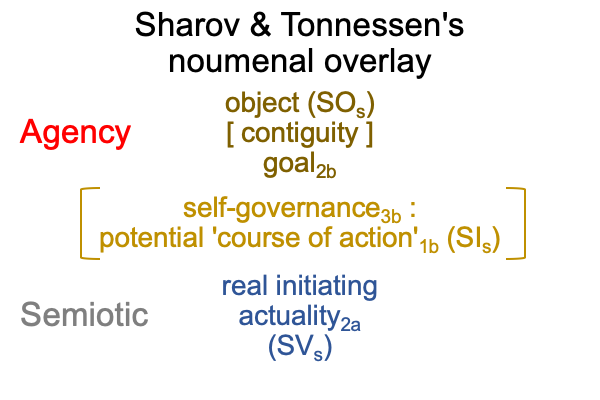0038 Section 1.2 wrestles with the possibilities of mathematical and mechanical models, based on truncated material and efficient causalities. Are these types of models capable of honestly portraying the autonomy, the goal-directedness, and the semiotic character of an agencyb(eventa)?
Say what?
Here is my reading. If the two-level interscope pictured above is real, then how can a scientist (who would rather not get into philosophical topics) study semiotic agency? If the two-level interscope is the thing itself, then what are its observable and measurable facets?
0039 Section 1.3 worries that the specifying sign-relation will disappear under a pile of independent applications, each proposing an empirio-schematic model, according to its own disciplinary language. How could each particular model overlay the um… noumenal overlay of sign-object2b(sign-vehicle2a)?
0040 Supposedly, all proposed mechanisms, like leaves in a giant leaf-pile, fall from the same tree. They cover the roots of the one life that they once all held in common, the noumenal overlay of the agencyb(semiotica). The tree is semiosis. The tree represents science beyond mere mechanism. So, as each specialization builds a successful model capable of substituting for the noumenal overlay, that specialization detaches from the semiotic tree, and falls to a mundane level of scientific inquiry.
0041 Say what?
In a play on the subtitle, the goal of the noumenal overlay is to reveal a science beyond natural-science mechanism, and in the process, open opportunities for novel sciences to figure out mechanisms appropriate to a science beyond mathematical and mechanical models.
0042 Ah, so that is what this book is all about.
Or is it?
The authors recognize that there is no consensus concerning the compatibility of semiosis and mechanisms. Theoretically, each sign could have its own science, whereby the sign’s mechanisms are modeled using a highly specific material-oriented and instrumental language. Furthermore, once a model is successful, it may replace its noumenal overlay, according to the style of triumphalist scientists, and thereby detach from the tree of semiosis, because the postulation of that tree is no longer necessary.
0043 The remainder of section 1.3 and all of 1.4 waffle around a question, asking, “Can we imagine that this multitude of mechanistic empirio-schematic leaves, covering the roots of the tree that originally embodied the agentb(eventa) paradigm that budded them, is linked to the tree of semiosis?”
0044 It is like not seeing the tree due to the abundance of fallen leaves.
Each leaf testifies to a mechanism that accounts for the observations and measurements of phenomena for one particular noumenon… or noumenal overlay… or something like that… and that mechanism, if successful, may be triumphantly placed over that one noumenon, and, in doing so, inquiry detaches from what?… the noumenon that all semiotic agencies have in common?
Once an empirio-schematic judgment successfully models the phenomena associated with its noumenon, then what use does it have for the thing itself?
Yes, all the models built by the sciences beyond (natural science) mechanism, one for each manifestation of semiotic agency, are like the dead leaves of autumn. One wonders whether they all belong to the same living noumenon, pictured above as Kull’s two-level interscope.
0045 Sharov and Tonnessen resolve this dilemma by formulating a noumenal overlay that allows scientists to identify which elements give rise to phenomena and which elements need to be explained by semiotic models.
0046 How do they accomplish this?
The very term, “semiotic agency”, offers a clue.
Kull’s interscope belongs to the category of thirdness. “Semiotic agency” transitions to the category of secondness. Secondness consists in two contiguous real elements. The two real elements are the content-level and situation-level actualities (SVs and SOs). The contiguity consists of the situation-level normal context and potential (SIs).
Here is a picture.

0047 A triadic structure (the specifying sign) may be transformed into a dyadic structure (the dyad of semiotic agency). Dyads are typical for the category of secondness, the realm of actuality. The above figure contains a fundament dyad and a resonant dyad. Both dyads may be compared to Aristotle’s hylomorphe, matter [substance] form.
